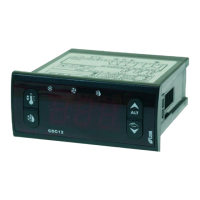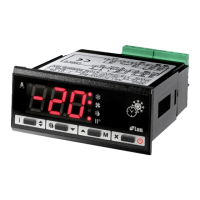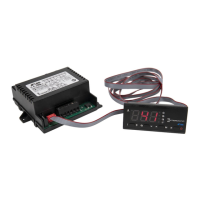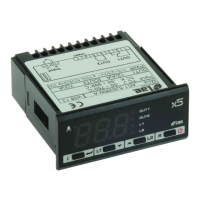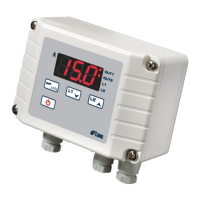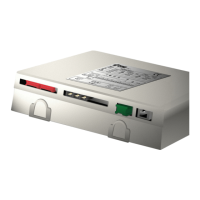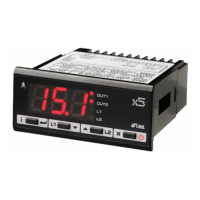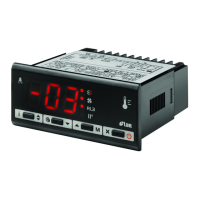4
24. minimum range, this value must match the minimum transmitter range, i.e. the
pressure corresponding to its minimum current (0/4mA).
25. maximum range, this value must match the maximum transmitter range, i.e. the
pressure corresponding to a 20mA current.
26. alternative SET input, if enabled (YES), when providing the required on voltage to
the relevant input, it shifts the control reference value, i.e. the dead zone mid value will
be parameter 6 instead of 5.
27. ... 34. output 1 ... 8 diagnostics, if enabled (YES), carries out a monitoring on the
corresponding output to detect an interruption by external causes. Differently (NO) the
voltage applied to the feedback inputs will have no effect on the controller operation.
35. Condenser High Pressure switch input, if enabled (YES), checks that the relevant
input always receives the required on voltage. If this condition is not fulfilled, the COPS
considers this as a high pressure alarm on the condenser side. If disabled (NO), this
input is not considered.
36. Suction Low Pressure switch input, if enabled (YES), checks that the relevant input
always receives the required on voltage. If this condition is not fulfilled, the COPS
considers this as a low pressure alarm on the suction side. If disabled (NO), this input is
not considered.
37. liquid level input, if enabled (YES), checks that the relevant input always receives the
required on voltage. With par.39 you add a time in which failure continuity is checked;
when this time expires, the COPS signals that there's a low refrigerant liquid alarm. If
disabled (NO), this input is not considered.
38. auxiliary alarm input, if enabled (YES), checks that the relevant input always
receives the required on voltage. If this condition is not fulfilled, the COPS signals this as
an auxiliary alarm. If disabled (NO), this input is not considered.
39. liquid level delay, if the relevant input does not receive the required on voltage for at
least this time, then a low liquid alarm takes place.
40. next maintenance, provides the amount of run hours of at least one compressor for
the maintenance warning to come up (LED [2]).
41. ... 48. output 1 ... 8 run time, allows to reset the hour counter for each output so as
to permit the programming of a new maintenance cycle.
49. 0 adjust, allows low range recalibration.
50. full scale adjust, allows span recalibration.
4 OPERATION
On every power-up, after self-check (4 sec approx.), the COPS 80 starts to control according to the
latest programmed values.
4.1 ST
AND-BY. With par.2=YES the control functions are suspended, the COPS proceeds to
progressively switching off all the outputs with fixed 5 sec steps and on area [7] of the
display "stand-by" appears.
This status remains even on following power-ups until the control is enabled again
(par.2=NO).
4.2 W
ARMING-UP. If par.15 is greater than zero, ex. 30 min, on power-up all outputs will
remain off during the programmed time and on area [7] of the display the seconds left to the
end of this phase are shown (1800, 1799, 1798,..).
4.3 PRESSURE CONTROL
. During the normal control phases, the COPS acts on the outputs to
constantly maintain the suction pressure around the reference value. Such value is given by
par.5 or, if par.26=YES and the set selection input receives the required on voltage, by
par.6.
If the measured pressure stays within the reference value ± the dead zone (par.7), the number
of switched on outputs will not change. If pressure exceeds par.5/6 + par.7, the on
sequence starts, differently, if the pressure drops lower than par.5/6
-
par.7, the off
sequence starts.
4.4 CUT
-IN DELAYS. When a suction pressure increase requires that an output is switched on,
before the switching takes place the COPS waits for this condition to constantly remain for a
time at least equal to: par.9 if, according to the control sequence, the next output is a
compressor, par.13 if a stage.
4.5 STOP DELA
YS. Before switching off an output because of a suction pressure drop, the COPS
waits for this condition to constantly persist for a time at least equal to: par.10 if, according
to the control sequence, the next output is a compressor, par.14 if a stage.
4.6 CONTROL SEQUENCE
. With par.20=YES, the compressor to be switched on(off) is
identified according to its last run(stop) time lapse, in other words the compressors are sorted
by length, from the longest to the shortest. Example, in this situation: C1=ON for 5 min.;
C2=OFF for 7 min., C3=OFF for 8 min., C4=ON for 6 min.; the sequence will be
ON
"C3,C2; OFF "C4,C1.
With par.20=NO, the sequence is always the same and follows the output order,
ON
"C1,C2,C3,C4; OFF "C4,C3,C2,C1.
However, a compressor cuts in if only all running compressors have achieved full power (all
stages on).
4.7 CUT
-IN LIMITATION. To avoid short cyclings reducing the compressor life, it's possible to limit
the starts per hour by setting par.11 greater than 0. In this case, as long as this rest time has
not elapsed, a compressor is excluded from the control sequence. If this happens, on the
basis of the selection mode (see 4.6), the COPS 80 gets started the first compressor fulfilling
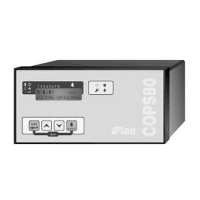
